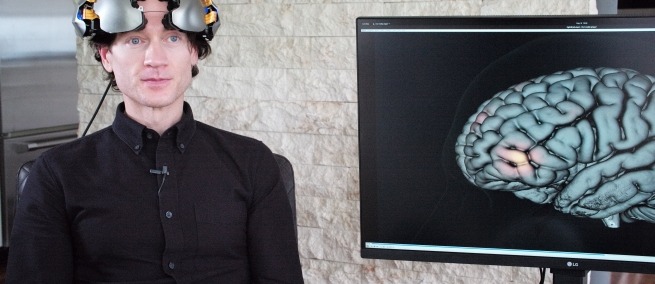

For Werner Herzog’s 35th feature-length documentary THEATER OF THOUGHT (2022), he chose the most complex scientific subject of our time, the brain, and tackles the sprawling areas of brain science and neurotech. The film doesn’t follow a straight line with its plot or geography, as Herzog shuttles between New York, Seattle, Munich, and elsewhere to interview researchers, entrepreneurs, and ethicists, spiced with his own commentary. Running for almost two hours, Herzog’s discursive but stimulating effort covers major threads in neuroscience and neurotech, from implanting wires in the brain to connect it to a computer, to musings about how the brain interprets the world.
In the opening scene, Herzog introduces himself and his travel companion, Rafael Yuste. This Spanish-born Columbia University neuroscientist, says Herzog, is at the “forefront of research that will change the world as much as the understanding of DNA has changed it.” Yuste is the film’s “methodical scientist,” and Herzog brings the views of a filmmaker and poet. After Yuste gives Herzog a crash course in the brain’s structure, they begin their road trip to learn more.
The first stop is at a rowing club in Seattle where we meet Christof Koch, a lead scientist at the Institute for Brain Science created by Microsoft cofounder Paul Allen. Koch studies human consciousness, but paradoxically sometimes quiets his own consciousness by rowing himself into the state of “flow,” where a person is so totally immersed in an activity that time hardly seems to pass. After rowing, Koch addresses the camera and holds up a thin, flexible disk the size of a pizza. He folds and crumples it, and explains how two similarly distorted disks of neural tissue sitting on either side of the brain form the cortex, from which comes everything – thoughts, sensations, emotions – that makes us human. This, says Koch, is the “central mystery:” how does the internal experience of human consciousness arise from the physical brain?
Koch explains that one way to begin answering this question is to study tiny mouse brains. It is not easy to translate what we learn from animals to humans, but Koch believes that research will eventually produce powerful brain-computer interfaces (BCIs) that can respond to minds. We see an early example when Herzog interviews entrepreneur Bryan Johnson, an ex-Mormon missionary who founded the California-based Kernel Company. He showcases a portable brain scanner, a helmet studded with optical sensors, that is meant to transform brain imaging. The sensors measure blood concentration in the brain, which indicates when a particular area is active. As a test, Yuste dons the helmet and firmly asserts that 5 + 5 = 11. Sure enough, the brain scan shows changes that correlate with the moment when Yuste misstates the truth.
This demonstration inspires Herzog’s next visit, to mathematician Kristin Lauter in Seattle, West Coast Head of Research Science in Facebook’s AI effort. True to Herzog’s style, he first elicits a personal note from Lauter, who relates her experiences as one of very few women in mathematics. Then he asks a key question: if neurotech can pull information out of a brain, can we protect this intimate personal data by encryption? Yes, she says: encryption could occur within a device like the Kernel helmet before the information is transmitted or stored elsewhere. But when Herzog asks if we can be absolutely sure that the encryption could never be broken, Lauter responds that this might be guaranteed for up to 50 years but not forever.
Leaving this somewhat unsettling answer lingering, Herzog conducts more interviews. Several display one successful form of neurotech, BCIs that mitigate neural conditions by directly entering the brain. The Kernel helmet and EEG caps detect brain activity non-invasively, but gathering data about specific brain functions instead requires connecting to selected neurons, which is done by implanting electrodes into or on the brain. These carry the brain’s electrical signals out to a computer or vice versa.
In the film, Eberhard Fetz, a neuroscientist at the University of Washington, relates how in 1969 he demonstrated an effective BCI for the first time when he trained a monkey with an implanted BCI to mentally control the pointer of an electrical meter. Later John Donoghue at Brown University showed that a BCI can control a prosthetic limb. His interview features a clip of a paralyzed woman who guides a robotic arm with her BCI to bring a water bottle to her lips, and sips through a straw. Her beaming face shows how meaningful this is for her. Another interview shows neurosurgeon Edward Chang, at the University of California San Francisco, placing a BCI with 128 electrodes onto the brain of a stroke victim who cannot speak. The BCI lets him communicate by translating brain signals into sentences shown on a screen.
Medical successes like these require advanced BCI technology. Among his interviewees, Herzog presents digital chip designer Ken Shepard at Columbia University, whose device will place 64,000 electrodes on the brain’s visual center to restore sight to the blind; and Russian-born MIT materials scientist Polina Anikeeva, who develops extremely thin optical fibers to provide non-intrusive entry to brains via light.
Underlying all this is fundamental brain research, also displayed in several interviews. Yuste uses a technique he invented that optically tags neurons in the tiny freshwater creatures called hydra, whose simple neural system gives hints to the operation of the 86 billion neurons in the human brain. We hear too from Joseph LeDoux at NYU, who identified the part of the brain associated with fear; then in an illuminating detour we learn what fear means to Herzog’s friend Phillippe Petit. In 1974 he daringly walked a tightrope strung between the World Trade Center twin towers, and discusses how he does not let fear rule him during such feats.
In many of the interviews, Herzog expands the conversation when he asks scientists quirkily provocative questions: Do we know that what the brain tells us is the true reality? Could a BCI transmit the thoughts in a brain after death? The researchers are visibly nonplussed by questions they would never encounter at a scientific meeting, but they rally to give thoughtful and sometimes very smart answers. The film further widens our view when Herzog and Yuste interview ethicists and a human rights lawyer grappling with a technology that could medically benefit millions and conceivably enhance brains, but raises questions about privacy, mind control, and regulation.
All these possibilities are still distant. As Herzog says in the film, fully understanding the human brain would change our world, but this will happen slowly. THEATER OF THOUGHT shows that grasping the complexity of the brain is an ongoing, decades-long project involving multitudes of researchers in different disciplines, and that the field has yet to explain the origin of consciousness or define what constitutes a thought. Still, we know enough to apply neuroscience to worthy causes, although some future scenarios envision harmful outcomes. In his final comments however Herzog says that his interviewees are “keenly alert to the ethical questions involved in neuroscience.” We can hope that wherever brain science and neurotech takes us, it will bring more good than harm.
FILMMAKERS
PARTNERS
TOPICS